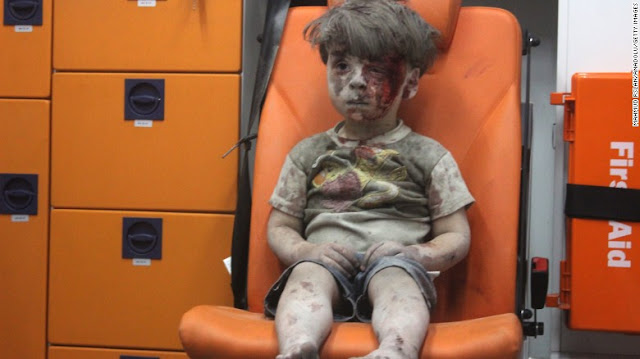After escaping war, what awaits Syrian children in Europe? 在逃離戰爭之後,在歐洲等著敘利亞孩子們的是什麼?
The haunting image of five-year-old Omran Daqneesh, shocked and
bloodied in the back of an ambulance after being pulled from the rubble of his
home, graphically captures the horrific situation facing Syria's children --
and makes it easy to understand why parents would take their children on the
desperate, arduous journey to Europe.
這張讓人難以忘懷的照片清清楚楚地捕捉到現在敘利牙孩子們正在面臨的可怕現況,流著血的五歲男童Omran Daqneesh滿臉充滿驚恐的樣子坐在救護車的後頭,他才剛從自己家的瓦礫堆中被救出來,這張照片也同時讓我們能夠了解為什麼爸爸媽媽們要帶著他們孩子踏上絕望、艱辛的歐洲之路。
But if a child like Omran were to survive the trip and reach Europe's
shores, their ordeal would be far from over.
但如果像是Omran這樣的孩子真的從旅途中存活了下來並抵達歐洲的海岸,他們的考驗才剛剛開始。
On a visit to the Greek island of Lesvos, I saw first-hand what awaits
them.
在造訪希臘列斯伏斯島時,我看到了最前線等著他們的考驗。
The scars of war戰爭帶來的傷痕
In a detention center on Lesvos I met Ahmed, a one-year-old baby who
has been sick for almost all of his short life from what his mother described
as a chemical attack.
在列斯伏斯島的拘留中心我遇見了Ahmed,他是一個一歲的寶寶,因為他的母親遭受到所謂的化學攻擊而導致他在他短短的人生幾乎都承受著病痛。
She told me that a bomb destroyed their home soon after Ahmed was born,
lodging shrapnel in his neck. Soon after, he developed severe asthma and other
symptoms consistent with chlorine gas inhalation. When I met him almost a year
after the bombing, I could see his scars and his little body struggled to
breathe.
她告訴我,在Ahmed出生之後,炸彈毀了他們的家,彈片插入了他的脖子,在那之後很快的,他得到了很嚴重的氣喘和其他因為吸入氯氣而產生的症狀,我在炸彈攻擊後快一年的時候認識他,我可以看到他的傷疤和他拼命想要呼吸的小小身軀。
His family are Palestinians from Syria, who first fled the horrors of
siege and starvation in Yarmouk camp, outside Damascus.
他的家族是來自敘利亞的巴基斯坦人,最初是因為長期遭受襲擊和饑餓的空聚而逃離在大馬士革之外雅爾矛克難民營。
But the war followed them as they fled to Idlib in the north of the
country. After a bomb hit their home, Ahmed's mother took them across the
border into Turkey where they paid smugglers to take them across perilous
waters in an overcrowded boat to the Greek islands.
但是戰爭也跟著他們來到了國家的北部伊德利卜省,在炸彈炸了他們家之後,Ahmed的母親跨越邊界來到土耳其,過程中他母親付錢給走私者,帶著他們坐著超載的船橫越危險的水域到希臘。
Once on land, Ahmed's family did not receive a warm welcome. They
arrived after the EU-Turkey deal came into effect on March 20 this year,
effectively transforming the islands into mass detention facilities.
一上岸,Ahmed的家族並沒有受到溫暖的歡迎,他們在今年三月二十號歐洲和土耳其之間的協定生效的那天後抵達,而這個協定有效地將這些島嶼變成大型的拘留中心。
Ahmed's family were locked up with more than 3,000 other people in
Moria detention center, closed off from the outside world by barbed wire
fences. When I saw them, they had no privacy and no idea what would happen to
them next.
Ahmed一家被關在超過三千人的Moria拘留中心,外面裝有尖銳的鐵絲柵欄與外界隔絕,當我看見他們,他們沒有任何隱私也完全不知道接下來在他們身上會發生什麼事。
Instead of quickly providing Ahmed with the urgent medical care he
needed, a doctor first gave the family a box of paracetamol.
比起快速提供給Ahmed所需要的醫療照顧,醫生獻給了他們家一盒撲熱息痛(一種解熱鎮痛藥)。
The family were later removed from detention but remain stranded in
Greece, like nearly 60,000 other refugees and migrants.
之後雖然他們一家能夠搬離拘留中心,但是在希臘依然無依無靠,而在希臘像他們一樣的難民或是移民者有將近60,000名。
Onward routes to Europe are mostly shut off. If it was up to some
European leaders, most would simply be deported back to Turkey.
前往歐洲的路線大多數都已經關閉了,如果是否能拘留是由一些歐洲首長決定,大多是都會被直接遣返回土耳其。
This desperate situation is being played out across Europe -- in
Hungary, Serbia, Greece, Calais and elsewhere.
這絕望的處境在歐洲(匈牙利、賽爾維亞、希臘、加來和其他地方)隨處可見。
Children forget how to read 孩子們忘記如何閱讀
Ahmed reminds me of so many children we have seen around the continent,
and the ordeals they face.
Ahmed讓我想起了很多在歐洲各處看到的孩子以及他們所面對的困難考驗。
Almost a third of refugees and migrants crossing the Mediterranean to
Europe are children. Many of them traveling alone, vulnerable to exploitation,
or separated from their families along the way, sometimes by the authorities
themselves.
跨越中東到歐洲的難民和移民者有將近三分之一是孩子,他們許多人是獨自一人、脆弱容易被利用、有些在途中和家人失散,有時候這些是官方本身所造成的。
Some of the children we've met have spent so long out of school that
they have forgotten how to read and write.
我們遇見的某些孩子因為已經脫離學校太久,已經忘記如何讀和寫。
One 16-year-old boy from Syria who has been in a camp on the Greek mainland
told us: "We have been here for 423 days with no hope, no education, no
schools. I need the chance to complete my studies."
一位在希臘難民營來自敘利亞的16歲男孩告訴我們:「我們已經過了423天沒有希望、沒有教育、沒有學校的日子,我需要能夠完成我的教育的機會。」
These children need safety, special care, education, and a roof over
their head. They need governments to allow and facilitate family reunification.
They need countries to follow through on their promises to relocate and
resettle families like Ahmed's.
這些孩子需要的是安全、特別的照顧、教育和一個能夠遮風避雨的屋頂,他們需要政府允許並且促進家族的重新團聚,他們需要國家遵守自己的諾言重新安置像Ahmed這樣的家庭。
In Europe, governments are shamefully behind on both fronts. European
Union leaders have relocated a fraction of the refugees they promised to take
last September.
在歐洲,政府可恥地躲在前線之後,歐盟領導者已經重新安置部分的難民就如同他們去年九月所承諾的。
While Omran, as Aylan Kurdi before him, captured the attention of the
world, heartbreak and outrage are not enough.
艾蘭·庫迪,之後是Omran,他們引起了全世界的注意,僅僅心碎和憤慨是不夠的。
The images have moved the world, but not leaders. Until they act,
thousands of children will suffer the same fates as Omran, Aylan and Ahmed.
這些影像打動了全世界,但沒有影響到那些領導者,直到他們採取行動,數千名小孩將會像是Omarn、艾蘭和Ahmed遭受到一樣的命運。
原文網址:http://goo.gl/9hPG0J






